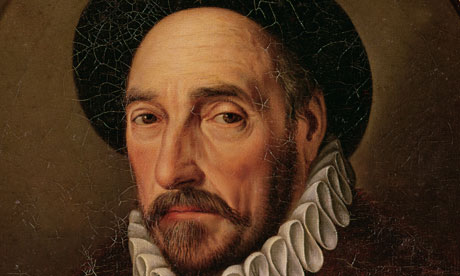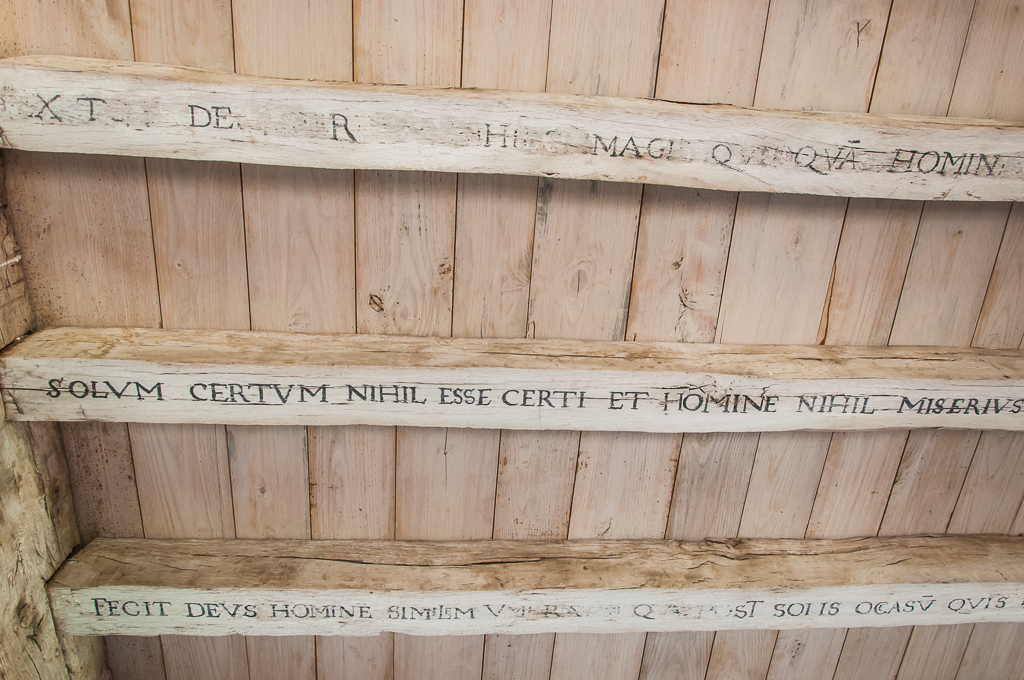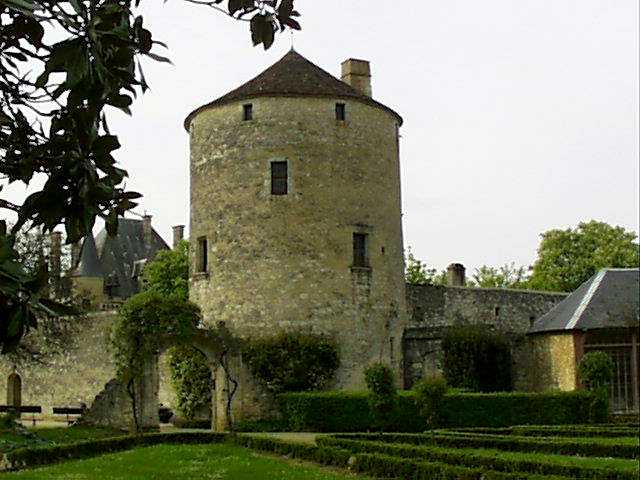Each summer and into the early fall, my wife, the painter Kathryn Jankus Day, and I take up residence at L’Étang, a 16th-century farmhouse on the estate of Michel de Montaigne just outside the village of St. Michel de Montaigne. The farmhouse sits in a valley near a pond below the Montaigne castle—a huge Disney-like 19th-century Loire valley imitation built after a maid set fire to the original castle in order to steal some jewelry. Or so the local story goes. Montaigne would be skeptical.
Montaigne’s tower (where he wrote his essays) did not burn, and to this day you can take a narrow, circular stone stairway up to his round study where there sits a full-sized cloth mannequin of Montaigne himself. He is arranged as if reading the facsimile of the Bordeaux edition of his essays on the table in front of him.
Above this faux Montaigne are carved into the ceiling beams his beloved quotations from the ancients: I don’t understand, I am in doubt, (both from Sextus Empiricus) among more than 50 others. The judgments of the Lord are a vast abyss (Psalm 35); There is much to be said on all matters, both for and against (Homer, The Iliad).
It will bring you luck (again, according to local lore) if, during your visit to Montaigne’s tower, you see on the stairs—or in the study itself—a black and white cat. The cat’s name is Balzac. He was once our cat, a lost-and-found kitty we rescued from a poplar woods near St. Michel de Montaigne, a woods we have since named Bois de Balzac. My wife and I not only have our patois, we are the ones who started the story about spotting Balzac in Montaigne’s tower bringing good luck. We believe in local lore.
Montaigne’s famous inquiry is persistent: What do we know? As is its modern corollary: How do we know? The first question was Montaigne’s motto: Que sais-je? The second concerns our age of “expanding information,” superhighways of information that race in an infinite number of lanes around the earth on cosmic beltways, complete with cloverleafs and exits—Paris, Rome, Athens, Bombay, Hong Kong, Los Angeles, Chicago, New York, St. Michel de Montaigne, Bly, Kansas—all going faster by far than “break-neck speed,” a phrase my mother would use to describe cars that passed our two-door Champion Studebaker as my father drove the R&P speed limit (Reasonable and Proper) on the roads of rural Kansas. Where are they going at “break-neck speed?” my mother would wonder. What madness is it? my father would reply.
Where are we all going at our 21st-century cosmic pace?—a pace that is not only to be contrasted with the R&P limits of 1950s Kansas roads, but with the walk-along rate of the Dordogne River that flows in the valley below Montaigne’s tower: past the village of Lamothe, Montravel, then west to Castillon, Branne, Libourne and Fronsac—after which it joins the Gironde near Bourg. Then to sea. Where is the strong brown god of the river going? At what speed? Are we flowing with it? What do we know?
Does it mean something to how we know that it would have taken Montaigne four days on horseback to follow the Dordogne to Bourg and back in order to learn—and return with—the news that the grape harvest along the Côte de Bourg was just as bad as it had been for the Côte de Castillon? Does it make a difference to what we know that my father had to drive to see my uncle (who had no phone) to tell him of a death in the family? And to return with my uncle who wanted to stay with us that night because, as my mother said, he was feeling “mortal,”—and that that was the first time I had heard that word and was afraid to ask its meaning. Is there a ratio of speed to knowledge? Of information to knowledge? Of information to ignorance? Which of these ratios are literal? Which are inverse, ironic? What do we ever know? Seeing Balzac brings you good luck. If you say so.
I like Montaigne’s way of thinking. In college I came to study him—as perhaps we all did—as the père of the essay. He was a master of “form.” There were forms of literature in those days: novels, poems, short stories, essays. We were taught that the French word essai meant “to try,” “to attempt.” I don’t remember any of us asking what we were to “attempt” when we took to writing our own essays; but over the years, it has occurred to me that in main we are to try to think. Not so much to “reason”—as if an essay were a pudgy syllogism—but to think in a contemplative way, a tentative way. An essay as a walk along a road taken in search of a discovered thought provoked by a singular image: the black bird in the cedar limbs just as it is beginning to snow—and is going to snow.
In this way we let our words discover our reason. Is it a way of knowing? Maybe. Is it a way of knowing everything? Maybe. It is a way of knowing yourself, then, to wit Montaigne: “There is nothing so contrary to my style as continuous narrative.” Walks with stops as digressions. Not a four-day, but a six-day trip to Bourg and back if on the way you ride your horse up the steep hill to St. Emillon and consider what there is to see. The Dordogne in the valley below. Someone on horseback riding toward Bourg. An essay on the move. The essay as a form of life. A way of knowing as a way of life.
—Robert Day
Robert Day’s new novel Let Us Imagine Lost Love premiered here on Numéro Cinq in its entirety as a serial novel and will be published in fall 2014 by Mammoth Publications. Prior to that, his most recent book was Where I Am Now, a collection of short fiction published by the University of Missouri-Kansas City BookMark Press. Booklist wrote: “Day’s smart and lovely writing effortlessly animates his characters, hinting at their secrets and coyly dangling a glimpse of rich and story-filled lives in front of his readers.” And Publisher’s Weekly observed: “Day’s prose feels fresh and compelling making for warmly appealing stories.”




Such a lovely piece of writing! I admire its pace enormously, and the notion of the essay as a walk towards discovering thought is compelling and helpful. Thank you.